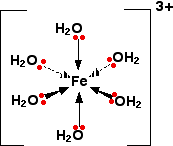Ligands occur in the context of coordination chemistry. And here a metal centre, a #"Lewis acid"#, is bound to several or so #"coordinating ligands"#.
In aqueous solution, we often write #M^(2+)(aq)#, where #M# is some transition metal, e.g. #Co^(2+), Fe^(3+), Fe^(2+), Mn^(2+)#. What we mean is the so-called aquated complex, #[M{(OH)_2}_6]^(2+)# where 6 water ligands, #"bind to"#, or #"coordinate to"# a metal centre. The resultant species is a so-called #"coordination complex"#, which has a (typical) octahedral geometry.
We can represent such an #Fe(III)# complex by the following picture.


The ligands can be exchanged by other species, which may bind more strongly to the Lewis-acidic metal centre. Typical ligands include #NH_3#, #X^-#, #PR_3#...........All of these ligands have a lone par of electrons that can coordinate to a metal centre. Different substitution of ligands, and different combinations, give rise to different colours, and different geometries. Can you tell me the ligands in the second illustration?
Note that these coordination compounds are (usually) cationic. Under certain circumstances, we could crystallize them out as the salt...........#[Fe{(OH)_2}_6]^(3+)Cl_3^(-)# (i.e. the choride counterions are along for the ride. The field of coordination chemistry is widely studied.

